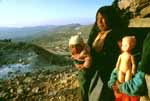|
go to photo essay |
Introduction A Monument to the Conquest  I first went to Potosí in 1991, as the South American correspondent of a
photo journalism agency, in anticipation of the five hundredth
anniversary of Colombus's voyage to America. Rather than glorify the
Age of Discovery, I felt it was important to show the other side of the
coin. My aim was to focus on a particular place, and document the
long-term effects of the conquest on the native people there. But why
choose Potosí, a forgotten mining town in the barren highlands of
Bolivia, as emblematic of the whole era?
The lust for treasure which motivated the Spanish was sated in 1545,
when they first cut into the Cerro Rico (Rich Mountain) of Potosí. For
over two hundred years, the mountain yielded more than half the world's
production of silver. This flow of wealth financed Spain's empire,
influenced the course of European economic development, and bolstered
Europe's trade relations with China. During the era of the Spanish
Empire, the Cerro Rico became world famous as a cornucopia of riches,
the subject of chronicles, poems and paintings that celebrated its
grandeur and generosity.
I first went to Potosí in 1991, as the South American correspondent of a
photo journalism agency, in anticipation of the five hundredth
anniversary of Colombus's voyage to America. Rather than glorify the
Age of Discovery, I felt it was important to show the other side of the
coin. My aim was to focus on a particular place, and document the
long-term effects of the conquest on the native people there. But why
choose Potosí, a forgotten mining town in the barren highlands of
Bolivia, as emblematic of the whole era?
The lust for treasure which motivated the Spanish was sated in 1545,
when they first cut into the Cerro Rico (Rich Mountain) of Potosí. For
over two hundred years, the mountain yielded more than half the world's
production of silver. This flow of wealth financed Spain's empire,
influenced the course of European economic development, and bolstered
Europe's trade relations with China. During the era of the Spanish
Empire, the Cerro Rico became world famous as a cornucopia of riches,
the subject of chronicles, poems and paintings that celebrated its
grandeur and generosity.
At the same time, the mining project in Potosí provoked one of the worst demographic disasters in history. In 1575, the viceroy of Peru, Francisco de Toledo, created the mita , a forced labor system that remained in place for 250 years. Under the mita, some three million Quechua Indians were compelled to work in the mines. Hundreds of thousands died there, of disease, from accidents, and at the brutal hand of their masters. Peasants fled as best they could, abandoning the land, but many were forced into reducciones, concentration areas where they could be counted and conscripted. Although some historians differ over the absolute numbers, most agree that, during the course of the mita (1575-1825), the native population of the Andes declined by eighty percent. I went to Potosí to find traces of this great crime in the daily life of the ten thousand or so mining families still working there. Over centuries, the descendants of the Quechua enslaved during the colonial period have successfully resisted the destruction of their culture, and they developed powerful symbolic ways of interacting with the Cerro Rico and with their own past. But in economic terms, these people never recovered from the mita : the Department of Potosí is the poorest place in all the Americas, a place where 230 babies born out of a 1000 die before their fifth birthday. I looked at both the rich culture of the miners, and their economic plight, as windows onto the mita. Life in Potosí has the feel of a cruel myth. The miners are compelled to repeat the past, working themselves to death in the same mountain that was the tomb of their ancestors. Inside the Cerro Rico, the men worship the devil (known as the Tio), a rapacious deity with the clothes of a miner and the beard of a Spaniard. Several times a year, they sacrifice llamas to this being, adorning the mouth of the mine with blood, so that he will not eat them. During carnival, the miners dance out their history, dressed as Spanish lords, African slaves, and as the Tio. Ever-present, the Cerro Rico looms iconically over the city, as if it were a gigantic monument to the conquest of the Americas. | |
| exhibit at SABA Gallery | return to photoarts | |
| Book & Purchase information | return to SABA | |
|
Online Exhibition Design by PhotoArts | ||